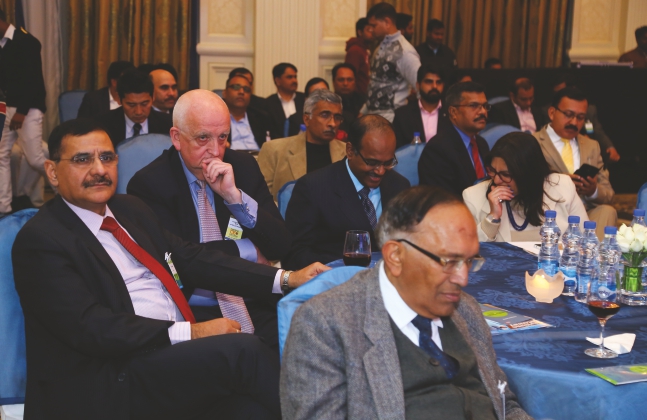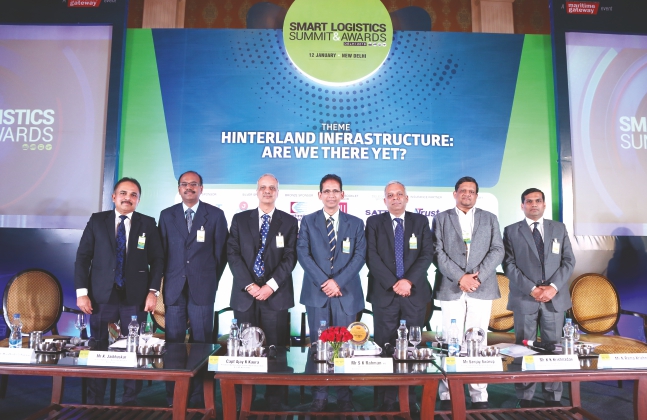The first session of Smart Logistics Summit held in New Delhi raised several concerns of the industry including the impact of GST on shipping cost, imbalance in import and export cargo, the need for establishing rail transshipment hubs to manage the rise in cargo when DFCs become operational and logistics challenges in hinterland.
GST tax was not a new levy, but was a combination of various taxes that had been subsumed into it. The purpose was to create a unified common national market and this move was expected to contribute to the growth of the GDP as well as increase industrial production, clarified S K Rahman, Additional Director General of Goods and Service Tax, as he spoke of the impact of GST on shipping industry. He stated that the the endeavor of the Government is to simplify the GST rules as much as possible.
With regard to impact of GST on shipping charges he clarified that the cargo whether export or import is taxable, the tax would be applicable on the shipping charges too. A distinction has been made on the GST rate for national and international transportation.
In order to minimize the Government interaction with the trade, a special purpose vehicle called GSTM has been created to facilitate the people. Sanjay Swarup, Director (International Marketing & Operations) Container Corporation of India, spoke of the problems faced by the industry. He said that 60 percent of the container business were concentrated in the northern hinterland for the west coast ports. Even though there was a network of terminals, direct connectivity, rolling stocks and state of art handling equipment, they have not seen a proportionate growth of cargo by rail from this region. Reasons attributed for the laggard growth in the container business are as under.
Imbalance of cargo import and export and high logistics costs There is disproportionate movement of cargo in the ports as well as the ICDs (Inland Container Depots). Some ports are more import oriented whereas other ports have large volumes of export cargo. Due to this skewed ratio empty containers need to be re-positioned to cater to the export cargo. This incurs additional expenditure which is passed on to the customers.
The logistics cost in India was about 14 per cent of GDP, whereas in other countries it was about 8 to 9 percent. There is a need to bring down the logistics costs to make Indian exports competitive in the world market.
Swarup feels that double stack containers is a solution of bringing down the cost due to this imbalance of cargo. There would be larger movement of cargo and faster evacuation. Any reduction of costs thus achieved could be passed on to the customers. He emphasized that the double stack container would help reduce running of empty container rakes.
Related to the imbalance of cargo is the concept of Rail transshipment hub. Today the one rake carries about 90 teus. Once the Dedicated Freight Corridor (DFC) is functional, the volume of cargo on the move would be quadrupled. Over 350 containers could be moved en masse at a time. It would be very difficult to garner this volume of cargo by a single terminal.
Multiple terminals to contribute the cargo:The solution therefore is to have a rail transshipment hub. The containers from the port would be evacuated en masse and brought to this hub from where the cargo would be segregated and despatched to various ICD terminals in the north. Advantage would be reduction of logistics costs and faster evacuation from the ports. Such an arrangement Swarup felt would reduce logistics costs as well as the evacuation from the port would be much faster.
Transit time: Sanjay conceded that at present the transit, a very important issue for customers was transit times. He said that at present many of the railway tracks were under repair. Also the container trains have to share the track with other commodities. It was a challenging time for the customers and other train operators. The DFC would be game changer and once operational would take care of all these problems.
Sharing of information with customers: Information technology tools, Swarup said, should be used in a big way. Other industries had already started using Apps in their day-to-day work with customers at various levels. Concor he said, had already commenced using APP and version 1 was going to be instated in the month of February. Basic functions would be introduced and after 2 months electronic filings would be commenced. All this was to ensure that customers have continuous cargo visibility. A customer sitting in Hong Kong or USA would be able to track his cargo.
Lastly Swarup raised the issue for last and first mile connectivity and warehousing. A new venture is being started which would be called the Distribution Logistics which would be unveiled soon.

K K Krishnadas, President & COO, International Cargo Terminals and Infrastructure Pvt Ltd. broadly endorsed what Swarup had to say. He felt that there was enough capacity. Further with the Kandla terminal and the PSA (Port of Singapore Authority) coming up at Nhava Sheva, the capacity requirements would be sufficient. He too felt that the imbalance of export and import cargo was a problematic issue.
N Rama Krishna, Head Business Development & OPS, Kribcho International Ltd said that there were 21 ICDs and Container Freight Stations (CFS) in the NCR (National Capital Region) and northern region. He was of the opinion that this imbalance would only be rectified with Government policies. There has been a 35 per cent increase in growth in export cargo volumes since 2016.
He felt that DFC was welcome, but after a single run of the rake, there would not be any volume of cargo to be carried from north for the next one week. It was therefore essential that there is consolidation among the like minded companies in the logistics sector.
With PSA and DP World setting up ports in Nhava Sheva, capacities will not be a constraint. Currently North India cargo is headed for Mundra and Pipavav. However with the new ports coming at Nhava Sheva, there is likely to be diversion of cargo to these ports. As far as Information Technology is concerned, there is an ever increasing dependence on it. CONCOR, DMIC ( Delhi Mumbai Industrial Corridor), the Indian Railways were already embracing Information Technology.
Capt Ajay K Kaura, President, NISAA & Vice President, K Line Pvt Ltd spoke on the challenges faced by the shippers based in the hinterland destinations. He said that there is a need for faster transit times, timely connections with the planned vessels.
Delays and inter terminals transfers at the port add to the delays and costs. Mishandling of containers and improper/inferior repair of containers need to be avoided which again add to delays and costs.
K Jaibhaskar, Head of Operations- North India & Gujarat, Maersk India Pvt Ltd, spoke from the perspective of a customer based in the hinterland. Delhi, he said was a market where many of the global retailers such as Walmart, Gap etc are based. Their paramount requirement was for reliability of loading of their container with the planned vessels. Some beginning has been made in this regard. Maersk has commenced a block train to cater to this demand, just as CONCOR has a scheduled train departure from Dadri. These are some of the beginning that have been made. But there is still a long way to go.
Another shortcoming which the customers in the NCR region want to be addressed is the movement of import refrigerated container to this region. Currently all import refrigerated containers are devanned at the port and brought to the NCR in refrigerated trucks. The additional handling of the cargo increases the cost for the importers. Jaibhaskar was cognizant of the problem faced by his customers.
Jaibhaskar further stated that in order to assist the customers Maersk Line had commenced end to end services ie door to door service. Maersk Line would pick up the cargo from the shipper premises and deliver the cargo to the consignee at his premises. The responsibility for the safe delivery of the cargo would rest with the line.








